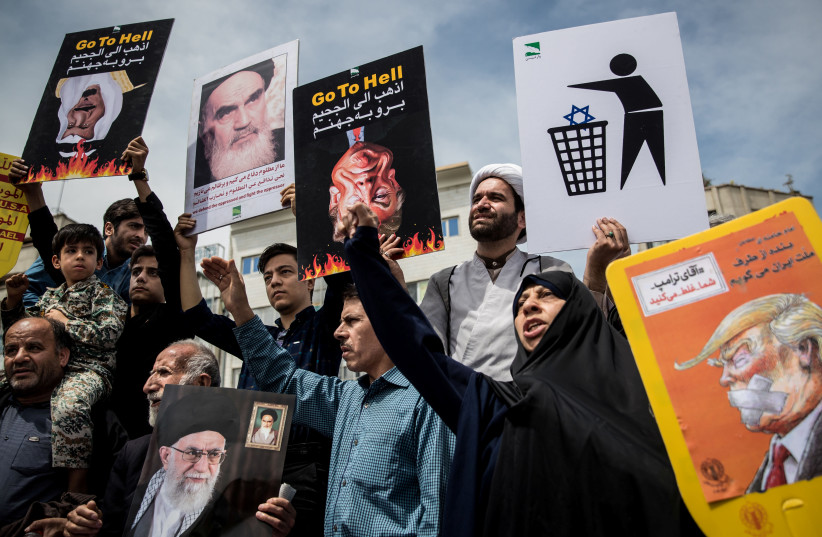Why did nothing come out of the European Union’s meeting on Wednesday with Iran?
YONAH JEREMY BOB

The parties to the Iran nuclear deal met late Wednesday for the first time since several crucial changes have taken place with the surprising signal being that the trajectory of the US-Iran standoff has cooled off a bit from deterioration to deadlock.
This slight cooling off is surprising because it would seem to be the opposite of the escalating deterioration that has taken place over the last two months.
First, the US killed Islamic Revolutionary Guard Corps Quds Force chief Qassem Soleimani on January 3.
In response to that or to US sanctions in general, Iran shortly after announced it would no longer abide by any of the nuclear deal’s limits.
There are debates about the exact numbers, but Iran now likely has gone from less than 300 kilograms of low-enriched uranium to around or more than the 1,000 kilograms of low-enriched uranium needed to make a nuclear bomb.
The EU-3 responded with its first sign of life and enforcement ability by declaring formally that Iran may be in fundamental violation of the deal and invoking a clock which could tick down to leading to UN-enforced global sanctions more serious than the US sanctions.
Last Friday, the FATF, a critical powerful international banking organization, blacklisted Iran for the first time since the nuclear deal was signed, because Iran had failed to pass anti-terror financing and anti-money-laundering legislation despite years of warnings to do so. Importantly, the FATF is viewed as heavily influenced by Europe and no one thinks the blacklist decision could have happened without European support.
Also, last Friday, Iran’s hardliners swept reformists out of the parliament in an election, seizing virtually all levers of power in the Islamic Republic other than now-isolated Iran President Hassan Rouhani.
Add to that the fact that the IAEA has made repeated recent statements that Iran violated the nuclear deal by concealing nuclear material from inspectors at the Turquzabad nuclear site discovered by the Mossad, and one might have expected an explosion at Wednesday’s meeting.
No explosion.
In fact, it seems that all the sides have taken their “pound of flesh” and now want to calm down, slow down and see what happens in the November US elections.
Since May 2019 when the US ended waivers from its Iran sanctions, Iran had grown more violent against the US and US allies and had violated the nuclear deal more and more.
But after announcing in January that it was no longer bound by the nuclear deal and deeply violating the low-enriched uranium threshold of around 5%, something surprising happened.
Iran ceased any additional violations.
It had threatened alternately to begin enriching uranium to the much more threatening mid-point of 20%, to throw IAEA inspectors out of the country or to leave the Nuclear Non-Proliferation Treaty. It has done none of the above.
The bottom-line is that Iran moved months closer to being able to manufacture a nuclear weapon, but by stopping where it is, it has still kept itself at least several months or more away from a nuclear weapon.
So maybe Iran had acted up enough and is now ready to wait on US elections.
The EU-3 have always been desperate to keep Iran within any limits of the nuclear deal and been ready to twist and turn in Iran’s favor to maintain that.
So while some might have though that Wednesday’s meeting would lead to the EU-3 leaving the deal, moving to snap back UN-global sanctions or at least to a new ultimatum deadline, reports are that such consequences were not even discussed.
On one hand, this completely erodes the EU-3’s credibility, if they had any, about confronting Iran.
On the other hand, maybe the EU-3 succeeded if their purpose in threatening Iran was to get it to halt its violations where it stood when they issued the snap back sanctions threat. Also, they did give Iran a bloody nose with the FATF blacklist decision.
So it is clear that they are ready to wait indefinitely on pressuring Iran more with snap-back sanctions as long as Tehran does not move closer to a nuclear bomb than it already has.
And Trump’s plan, despite killing Soleimani, is very clearly an economic sanctions marathon against Iran.
There is no other plan. If it works and Iran changes its behavior, great. If not, then at least as long as Iran does not move to get a nuclear weapon, the US is not going to up the stakes with a use of military force as things stand.
This does not mean everything will be smooth sailing from now until November.
But if from May 2019 until February 2020 were a time of extreme instability in the nuclear standoff, we may have entered a “timeout” and wait-and-see period of sorts pending the big contest in November.
Content retrieved from: https://www.jpost.com/Middle-East/The-Iran-nuke-front-from-deterioration-to-deadlock-analysis-619001.